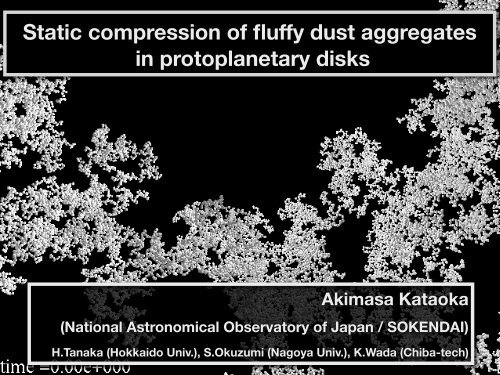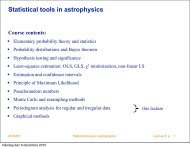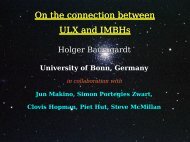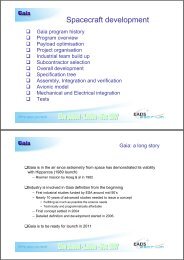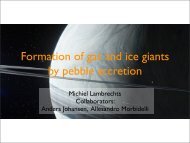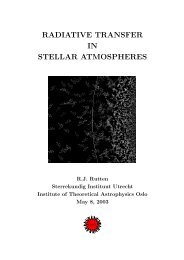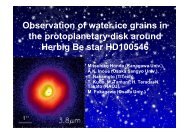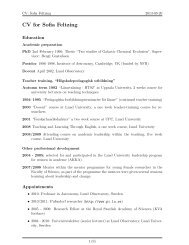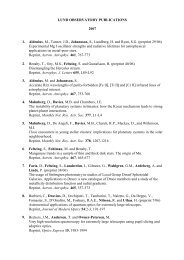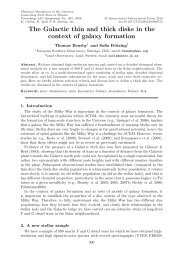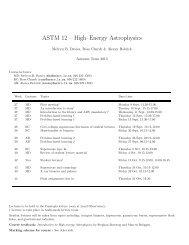Static compression of fluffy dust aggregates in ... - Lund Observatory
Static compression of fluffy dust aggregates in ... - Lund Observatory
Static compression of fluffy dust aggregates in ... - Lund Observatory
You also want an ePaper? Increase the reach of your titles
YUMPU automatically turns print PDFs into web optimized ePapers that Google loves.
<strong>Static</strong> <strong>compression</strong> <strong>of</strong> <strong>fluffy</strong> <strong>dust</strong> <strong>aggregates</strong><br />
<strong>in</strong> protoplanetary disks<br />
Akimasa Kataoka<br />
(National Astronomical <strong>Observatory</strong> <strong>of</strong> Japan / SOKENDAI)<br />
H.Tanaka (Hokkaido Univ.), S.Okuzumi (Nagoya Univ.), K.Wada (Chiba-tech)
Porosity <strong>in</strong> <strong>dust</strong> coagulation<br />
constant<br />
density<br />
coagulation<br />
unrealistic<br />
porosity<br />
evolution<br />
coagulation<br />
realistic<br />
Recent studies have shown that <strong>dust</strong> gra<strong>in</strong>s<br />
grow to <strong>fluffy</strong> <strong>aggregates</strong><br />
cf). Wada et al. 2007, 2009, 2011, Suyama et al. 2008,2012, Okuzumi et al. 2009,2012<br />
Akimasa Kataoka, Ice and Planet Formation @ <strong>Lund</strong>, May 16th, 2013<br />
2
Planetesimal formation with <strong>fluffy</strong> <strong>aggregates</strong><br />
<strong>in</strong>ternal density<br />
0.1μm<br />
1g/cm 3<br />
ISM<br />
1m 1km 10 2-4 km radius<br />
Planetesimals<br />
Other <strong>compression</strong> <br />
mechanisms are required<br />
cf). Wada et al. 2009,<br />
Okuzumi et al. 2009,2012 ,<br />
Suyama et al. 2008,2012<br />
10 -5 g/cm 3<br />
Collisional Compression<br />
Akimasa Kataoka, Ice and Planet Formation @ <strong>Lund</strong>, May 16th, 2013 3
Aim <strong>of</strong> this work<br />
<strong>in</strong>ternal density<br />
1μm<br />
1g/cm 3<br />
ISM<br />
<strong>Static</strong> <strong>compression</strong><br />
<br />
by gas pressure<br />
gas<br />
10 -5 g/cm 3<br />
1m 1km 10 2-4 km radius<br />
Planetesimals<br />
<strong>Static</strong> <strong>compression</strong><br />
by Self-gravity<br />
gravity<br />
r<br />
We <strong>in</strong>vestigate static <strong>compression</strong> <strong>of</strong><br />
highly porous <strong>aggregates</strong><br />
Akimasa Kataoka, Ice and Planet Formation @ <strong>Lund</strong>, May 16th, 2013 4
Strategy<br />
1. we drive static compressive strength by us<strong>in</strong>g N-body<br />
simulations (Kataoka et al. 2013, A&A accepted, arXiv:1303.3351)<br />
2. we apply the compressive Physical Model strength to protoplanetary disks<br />
with a given pressure = ram pressure <strong>of</strong> gas, self gravity.<br />
Particle-Particle Interaction<br />
(Kataoka et al. <strong>in</strong> prep)<br />
(a) Repulsion/Adhesion (Johnson<br />
et al., 1971)<br />
(b) Roll<strong>in</strong>g<br />
(Dom<strong>in</strong>ik & Tielens, 1995)<br />
(c) Slid<strong>in</strong>g<br />
(Dom<strong>in</strong>ik & Tielens, 1996)<br />
(d) Twist<strong>in</strong>g<br />
(Dom<strong>in</strong>ik & Tielens, 1996)<br />
Direct-<strong>in</strong>teraction model<br />
cf).Dom<strong>in</strong>ik & Tielens 1997, Wada et al. 2007<br />
(figure: Seiz<strong>in</strong>ger et al. 2012)<br />
Akimasa Kataoka, Ice and Planet Formation @ <strong>Lund</strong>, May 16th, 2013 5
Monomer radius r [µm] 0.1 0.6<br />
Surface energy<br />
0<br />
[mJ m 2 ] 100 20<br />
Young’s modulus E [GPa] 7.0 2.65<br />
Poisson’s ratio ⌫ 0.25 0.17<br />
Material density ⇢ 0 [g cm 3 ] 1.0 2.65<br />
critical roll<strong>in</strong>g displacement ⇠ crit [Å] 8 20<br />
Periodic boundary<br />
gure 2 <strong>in</strong> Wada et al. (2007)). We <strong>in</strong>troduce a damp<strong>in</strong>g<br />
etween contact particles <strong>in</strong> normal direction, def<strong>in</strong>ed as<br />
k n<br />
m 0<br />
t 0<br />
n c · v r , (4)<br />
n is the damp<strong>in</strong>g coe<br />
cient <strong>in</strong> normal direction and m 0 is<br />
nomer mass. The adopted value <strong>of</strong> k n is an order <strong>of</strong> 0.01.<br />
that the result is <strong>in</strong>dependent <strong>of</strong> the normal oscillation<br />
g, we perform N-body simulations with the damp<strong>in</strong>g facs<br />
a parameter.<br />
L timescale <strong>of</strong> damp<strong>in</strong>g is<br />
t 0<br />
k n<br />
⇠ 10 2 t 0 , (5)<br />
= 0.01, is much shorter than the simulation timescale,<br />
is typically ⇠ 10 7 t 0 . We show that the obta<strong>in</strong>ed comn<br />
strength is <strong>in</strong>dependent <strong>of</strong> the artificial normal damp<strong>in</strong>g<br />
our simulations (see Section 3.4).<br />
L<br />
Boundary condition<br />
L<br />
a part <strong>of</strong> a large aggregate<br />
iform Compression by Mov<strong>in</strong>g Boundaries<br />
Fig. 1. Schematic draw<strong>in</strong>g <strong>of</strong> the periodic boundary condition. Each<br />
pt the periodic boundary The condition <strong>dust</strong> <strong>in</strong> our <strong>aggregates</strong> simulations. <strong>of</strong>are the box compressed illustrates a boundary box by with themselves<br />
a side length L for all direction.<br />
When the boundary starts to get closer, the aggregate sticks to the<br />
gregate <strong>in</strong> the computational region is surrounded by its<br />
as shown <strong>in</strong> Figure 1. Initially, over wethe set aperiodic cubic box whose boundaries<br />
neighbor<strong>in</strong>g <strong>aggregates</strong> over the boundary and compressed by them. It<br />
re periodic boundaries withL<br />
should be noted that this picture is illustrated <strong>in</strong> 2D direction, but our<br />
a size <strong>of</strong> L to be larger than<br />
simulations are performed <strong>in</strong> 3D.<br />
regate. Thus, the <strong>in</strong>itial →natural BCCA cluster isand detached isotropic from <strong>compression</strong><br />
hbor<strong>in</strong>g copies over the periodic boundaries. In our sims,<br />
we gradually move the boundaries to the center <strong>of</strong> the The computational cubic region has length L and the coord<strong>in</strong>ates<br />
Planet <strong>in</strong>Formation x, y, and @ z directions <strong>Lund</strong>, May are 16th, set2013 to be L/2 < x < L/2, te to become closer to each other. As Akimasa a result, Kataoka, the aggre- Ice and 6<br />
L
Simulation sett<strong>in</strong>g<br />
BCCA (Ballistic Cluster-Cluster Aggregation)<br />
•Initial aggregate: BCCA<br />
= No <strong>compression</strong>, suitable for <strong>in</strong>itial<br />
condition<br />
•the fill<strong>in</strong>g factor φ <strong>in</strong>creases with time<br />
•We measure φ and P at each time<br />
→to derive P=P(φ)<br />
•The pressure measur<strong>in</strong>g method is<br />
the same as molecular dynamics<br />
cf)<br />
= / 0<br />
movie: H.Tanaka<br />
: <strong>in</strong>ternal desnity<br />
0: material density(=1 g/cc)<br />
Purpose: we derive P=P(φ)<br />
Akimasa Kataoka, Ice and Planet Formation @ <strong>Lund</strong>, May 16th, 2013 7
Initial condition : BCCA<br />
Particle number : 6×10 4<br />
Monomer : 0.1μm, ice<br />
<br />
http://www.youtube.com/watch?<br />
feature=player_embedded&v=AY6eq_S6uKE
sumed to be a BCCA clu<br />
5. Summary<br />
Fig. 3. Time evolution <strong>of</strong><br />
Results<br />
static <strong>compression</strong> <strong>in</strong> the<br />
:<br />
case<br />
<strong>compression</strong><br />
<strong>of</strong> N = 16384. The three figures have<br />
strength<br />
model is based on Dom<strong>in</strong><br />
0.1<br />
the same scale with di↵erent time epoch. The<br />
white particles are <strong>in</strong>side a box enclosed by the periodic boundaries. The yellow particles are <strong>in</strong> neighbor<strong>in</strong>g boxes to the box <strong>of</strong> white particles.<br />
For Fig. visualization, 13. we Same do notas draw Figure the copies 12, <strong>in</strong> back butand plotted front side with <strong>of</strong> thel<strong>in</strong>ear boundaries scale but only <strong>of</strong> 8 copies andWe (2007). <strong>in</strong>vestigate We the <strong>in</strong>troduce static comp a ne<br />
<strong>of</strong> the white particles across the boundaries.<br />
reversal <strong>of</strong> xy axis to compare with previous studies (see Figure 4 <strong>in</strong><strong>dust</strong>the <strong>aggregates</strong>, periodic boundary whose fill<strong>in</strong>g cond<br />
0.0 Individual runs<br />
Average<br />
Seiz<strong>in</strong>ger et al.<br />
10 5 (2012)). The dotted (a) l<strong>in</strong>e is the result <strong>of</strong> numerical<br />
10 5 simulations<br />
<strong>in</strong> the<br />
(b) gregate <strong>of</strong> ten uniformly runs<br />
10 4 10 3 10 2 10 1 10 0 10 1 10 2 10 3 10 4 10 5 10 6 perform numerical N-body and natu sim<br />
10 4 high density region<br />
P [Pa]<br />
( & 0.1) <strong>in</strong> Seiz<strong>in</strong>ger et al.<br />
10 4 average (2012) highly ary<br />
<strong>of</strong> ten runs porous condition, <strong>dust</strong>the <strong>aggregates</strong> <strong>dust</strong> and the th<strong>in</strong> solid l<strong>in</strong>e is the fitt<strong>in</strong>g formula proposed by GüttlerE roll et<br />
10 3<br />
10 3<br />
⇥al.<br />
sumed resents to bea part a BCCA <strong>of</strong> a large cluster. ag<br />
3<br />
r0<br />
(2009). Our results consistently connect to the previous simulations 3 <strong>in</strong>model theis <strong>compression</strong> based on Dom<strong>in</strong>ik <strong>of</strong> a large &<br />
the high density<br />
10 2 region.<br />
10 2 (2007). moveWe toward <strong>in</strong>troduce the center a newan<br />
m<br />
. 13. Same as Figure 12,<br />
10 1 time<br />
but plotted with l<strong>in</strong>ear scale <strong>of</strong> and<br />
10 1<br />
becomes small. To measu<br />
ersal <strong>of</strong> xy axis to compare with previous studies (see Figure 4 <strong>in</strong><br />
the timeperiodic<br />
boundary conditio<br />
z<strong>in</strong>ger by cluster-cluster et al. (2012)).<br />
10 0 aggregation. The dotted l<strong>in</strong>eA islarge the result void<strong>of</strong>exists numerical 10 0 between simtions<br />
gregate adopt uniformly a similarand manner naturall use<br />
the<br />
two<br />
<strong>in</strong><br />
smaller<br />
the high<br />
10 clusters 1 density<br />
and<br />
region<br />
they<br />
(<br />
are<br />
&<br />
connected<br />
0.1) <strong>in</strong> Seiz<strong>in</strong>ger<br />
with10 one<br />
et 1 al.<br />
connection<br />
(2012) ary As condition, a result the <strong>of</strong> the <strong>dust</strong> numeric aggreg<br />
the th<strong>in</strong> solid l<strong>in</strong>e is the fitt<strong>in</strong>g formula proposed by Güttler et al. resents as follows. a part <strong>of</strong> a large aggre<br />
<strong>of</strong> monomers<br />
10 2 <strong>in</strong> contact, represented by dashed10 l<strong>in</strong>e 2 <strong>in</strong> the right<br />
09). Our results consistently connect to the previous simulations <strong>in</strong> the <strong>compression</strong> <strong>of</strong> a large ag<br />
panel <strong>of</strong> Figure<br />
10 3 14. The <strong>compression</strong> <strong>of</strong> the BCCA<br />
10 3 cluster occurs<br />
by crash<strong>in</strong>g<br />
– The <strong>compression</strong> stren<br />
high density region.<br />
move toward the center and th<br />
10 4 the large void, which requires only roll<strong>in</strong>g <strong>of</strong><br />
the monomers at the connection.<br />
10 4 becomes small.<br />
P = E roll To 3 measure<br />
Now, 10 let us 5 estimate the <strong>compression</strong> strength. 10 In 5 adopt a similar<br />
static <strong>compression</strong>,<br />
10 the aggregate<br />
r 3 manner , used <strong>in</strong><br />
cluster-cluster aggregation. A large void exists between the<br />
0<br />
10 6<br />
As a result <strong>of</strong> the numerical s<br />
smaller clusters 4 and they is<br />
10 3 compressed are connected<br />
10 2 by<br />
10 1 with external one<br />
10 0 10connection<br />
pressure.<br />
10 6 4 Each<br />
10 3 as follows. 10 2 where 10 1 E 10<br />
BCCA cluster feels a similar pressure, P. Us<strong>in</strong>g the pressure, the<br />
0 roll is the roll<strong>in</strong><br />
monomers <strong>in</strong> contact, represented by dashed l<strong>in</strong>e <strong>in</strong> the right<br />
(density)<br />
(density) the monomer radius, a<br />
el force <strong>of</strong> Figure on the BCCA 14. Thecluster <strong>compression</strong> is approximately <strong>of</strong> the BCCA givencluster by ocs<br />
by crash<strong>in</strong>g<br />
– The<br />
the<br />
<strong>compression</strong><br />
fill<strong>in</strong>g factor<br />
strength<br />
as<br />
Fig. 4. (a) Pressure P <strong>in</strong> [Pa] aga<strong>in</strong>st the fill<strong>in</strong>g factor . The ten th<strong>in</strong> solid l<strong>in</strong>es show the results for the <strong>in</strong>itial BCCA clusters with di↵erent<br />
<strong>in</strong>itial<br />
F ⇠random P · r 2 numbers BCCA . the large void, which requires only roll<strong>in</strong>g <strong>of</strong><br />
(30) <strong>of</strong> the whole aggregate<br />
monomers at the and thick We connection.<br />
solid derive l<strong>in</strong>e showsthe arithmetic compressive average <strong>of</strong> the tenstrength runs. (b) Same as the thick P solid = Equation E roll<br />
l<strong>in</strong>e <strong>in</strong> (a) 3 , plotted (35) . withisa dotted <strong>in</strong>dep<br />
l<strong>in</strong>e Now, <strong>of</strong> Equation let us (25). estimate The parameters theare <strong>compression</strong> N = 16384, C v = strength. 3 ⇥ 10 7 , k n = In 0.01, static and ⇠ crit comssion,<br />
S<strong>in</strong>cethe aggregate crash<strong>in</strong>g <strong>of</strong> isthe compressed large voidbyisexternal accompanied pressure. by roll<strong>in</strong>g Each <strong>of</strong><br />
= 8 Å.<br />
r<br />
the 3 0number <strong>of</strong> particles<br />
the boundary speed, th<br />
CA a When pair cluster <strong>of</strong> the monomers <strong>compression</strong> feels a similar proceeds <strong>in</strong> contact, Akimasa pressure, and Kataoka, the the density P. Ice work Us<strong>in</strong>g and becomes Planet required the Formation e↵ective pressure, for @ sound the <strong>Lund</strong>, the speed crash-<br />
where E<br />
May 16th, can be 2013 estimated as roll is the roll<strong>in</strong>g e<br />
9<br />
P [Pa]
ticles, which is equivalent toWe the <strong>in</strong>vestigate di↵erentthe sizes static <strong>of</strong> <strong>compression</strong> the <strong>in</strong>il<br />
<strong>dust</strong> <strong>aggregates</strong>. Figure 6 shows dependence on the num-<br />
10highly 0 porou<br />
strength <strong>of</strong><br />
rmula proposed by<br />
r <strong>of</strong> particles <strong>of</strong> the Results<br />
<strong>dust</strong> Güttler<br />
<strong>in</strong>itial BCCA: cluster. dependence<br />
<strong>aggregates</strong>, et whose al. resents a part <strong>of</strong> a l<br />
fill<strong>in</strong>g<br />
The <strong>in</strong>itial numbers on<br />
factor<br />
size<br />
is lower than<br />
10 1 0.1. W<br />
1<br />
ct10 2 to10the 3 4 previous<br />
10 5 10 6<br />
simulations<br />
perform numerical<br />
<strong>in</strong><br />
N-body<br />
the<br />
simulations<br />
<strong>compression</strong><br />
<strong>of</strong> static <strong>compression</strong><br />
<strong>of</strong><br />
o<br />
a]<br />
highly porous <strong>dust</strong> <strong>aggregates</strong>. The <strong>in</strong>itial <strong>dust</strong> aggregate<br />
10 5<br />
10 2 is a<br />
sumed to be a BCCA cluster. The particle-particle <strong>in</strong>teractio<br />
10 4 N=16384 model is based on Dom<strong>in</strong>ik & Larger Tielens N (1997) 10and 3 Wada et a<br />
N=4096 (2007). We <strong>in</strong>troduce a newbecomes method → well forfitted <strong>compression</strong>. small. to lower<br />
10 3<br />
10 4 We φTo<br />
adop<br />
tted with l<strong>in</strong>ear scale <strong>of</strong> and<br />
evious studies (see Figure N=1024 4 <strong>in</strong><br />
the periodic boundary condition <strong>in</strong> order to compress the <strong>dust</strong> ag<br />
e is the result<br />
10 2 <strong>of</strong> numerical E roll<br />
⇥sim-<br />
gregate uniformly and naturally. adopt 10 5<br />
3 →The<br />
Because a similar <strong>compression</strong><br />
<strong>of</strong> the periodic man bound<br />
large<br />
r0<br />
0.1) <strong>in</strong> Seiz<strong>in</strong>ger voidet al. exists 3 (2012) ary<br />
between<br />
condition, the<br />
the<br />
<strong>dust</strong> aggregate <strong>in</strong> computational<br />
10 1<br />
strength formula 10<br />
10 6 region rep<br />
As a result <strong>of</strong>is<br />
mula proposed by Güttler et al.<br />
valid to lower φ<br />
4 the n<br />
resents a part <strong>of</strong> a large aggregate, and thus we can <strong>in</strong>vestiga<br />
10<br />
onnected t to the previous<br />
10 0<br />
simulations with one <strong>in</strong> time theconnection<br />
<strong>compression</strong> <strong>of</strong> a large<br />
as<br />
aggregate.<br />
follows.<br />
The periodic boundarie<br />
move toward the center and the distance between the boundarie<br />
ed by dashed<br />
10 1 l<strong>in</strong>ebecomes the small. right To measure the pressure <strong>of</strong> the aggregate, w<br />
arge void<br />
10<br />
exists 2<br />
adopt a similar manner used <strong>in</strong> molecular dynamics simulation<br />
ion <strong>of</strong> the between BCCA the cluster oc-<br />
by dashed requires l<strong>in</strong>e <strong>in</strong> the right only<br />
– The Fig. 7. compressio<br />
As a result <strong>of</strong> the numerical simulations, our Dependence ma<strong>in</strong> f<strong>in</strong>d<strong>in</strong>gs onar<br />
th<br />
nnected with<br />
10 3 one connection<br />
ten <strong>in</strong>itial conditions varyi<br />
dhich<br />
as follows.<br />
roll<strong>in</strong>g <strong>of</strong><br />
k n = 10 2 , and k n = 10 1 .<br />
on <strong>of</strong> the BCCA<br />
10 4 cluster ocich<br />
requires<br />
– The <strong>compression</strong> strength can beother written parameters as are N = 1<br />
P = E roll 3<br />
10 5 only roll<strong>in</strong>g <strong>of</strong><br />
P = E roll<br />
ssion strength. In static 3 , and ⇠ crit = 8 Å. Each(35<br />
l<br />
ssion strength.<br />
10 6 In static comd<br />
by external 10 pressure. 4 10Each<br />
3 10 2 0<br />
r 3 comed<br />
by external pressure. where E 10 Each<br />
1 10 0 that the<br />
r 3 ,<br />
k n = 0, 10 0 2 , and 10 1 , r<br />
(<br />
normal<br />
ht<br />
c-<br />
<strong>of</strong><br />
as follows.<br />
The compressive strength<br />
– The <strong>compression</strong> strength can be writte<br />
Eroll<br />
P = E roll<br />
3 ,<br />
m-<br />
ch<br />
he<br />
cf)<br />
r 3 0<br />
where E roll is the roll<strong>in</strong>g energy <strong>of</strong> mon<br />
the monomer radius, and is the fill<strong>in</strong><br />
the fill<strong>in</strong>g factor<br />
= / 0<br />
as<br />
Energy required<br />
= ⇢/⇢<br />
<strong>of</strong> monomers<br />
0 , where ⇢<br />
Eroll: roll<strong>in</strong>g energy<br />
r0: monomer radius<br />
φ: fill<strong>in</strong>g factor ( )<br />
<strong>in</strong> contact to rotate 90°<br />
0)<br />
<strong>of</strong><br />
h-<br />
<strong>of</strong> the whole aggregate, and ⇢ 0 is the m<br />
Equation (35) is <strong>in</strong>dependent <strong>of</strong> the nu<br />
the number <strong>of</strong> particles, the size <strong>of</strong> the<br />
the boundary speed, the normal damp<strong>in</strong><br />
In application:<br />
We use the compressive strength formula as φ=φ(P), to obta<strong>in</strong><br />
the φ <strong>in</strong> a given pressure (=ram pressure <strong>of</strong> gas, self gravity)<br />
Akimasa Kataoka, Ice and Planet Formation @ <strong>Lund</strong>, May 16th, 2013 11
sal <strong>of</strong> xy axis to compare with previous studies (see Figure 4 <strong>in</strong><br />
nger et al. (2012)). The dotted l<strong>in</strong>e is the result <strong>of</strong> numerical simns<br />
<strong>in</strong> the high density region ( & Conclusions<br />
0.1) <strong>in</strong> Seiz<strong>in</strong>ger et al. (2012)<br />
he th<strong>in</strong> solid l<strong>in</strong>e is the fitt<strong>in</strong>g formula proposed by Güttler et al.<br />
). Our results consistently connect to the previous simulations <strong>in</strong><br />
igh density region.<br />
• We <strong>in</strong>vestigate the the static compressive strength <strong>of</strong> highly<br />
porous <strong>aggregates</strong> (φ


